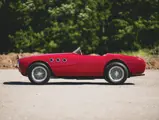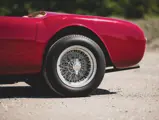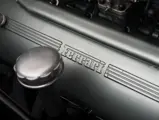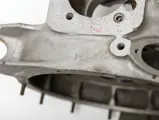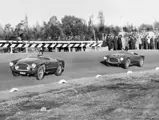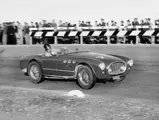
1952 Ferrari 225 Sport Spider by Vignale
{{lr.item.text}}
$4,000,000 - $5,000,000 USD | Not Sold
{{bidding.lot.reserveStatusFormatted}}
- One of twelve examples fitted with Vignale spider coachwork
- Raced in the U.K. and Argentina through the 1950s
- Fitted with spare engine (0225 EL) and matching-numbers gearbox
- Includes original engine block, no. 0214 ED
- Offered from nearly two decades of single ownership
- Eligible for all major vintage events: Tour Auto, Le Mans Classic, the Mille Miglia, and Monaco Grand Prix Historique
THE 225 SPORT
In 1952 Ferrari introduced a large-displacement, more powerful version of the 212 Export, aptly christened the 225 Sport in following with the company’s practice of naming models for the cubic displacement of a single cylinder and continuing the steady evolution of the Colombo V-12. Only twenty chassis were produced to this rare specification, the majority of which were bodied by Vignale of Turin, which had begun to succeed Touring as the company’s favored competition coachbuilder.
Accordingly, these cars are both healthy performance machines, boasting 150 bhp, as well as an important styling bellwether for future Ferrari customer competition spiders, serving as an interim link between the “early years” of Ferrari and the introduction of the long-lived, legendary 250 series of cars that followed. They were credited with over 60 class and overall victories in numerous events, including the Mille Miglia, Giro di Sicilia, and the Portuguese Grand Prix, as well as a 1-2-3 achievement at Monaco in 1952; their drivers were a memorable all-star roster of the greatest international drivers of their era.
CHASSIS NUMBER 0214 ED: A SPIDER BY VIGNALE
Chassis number 0214 ED was the tenth of twelve 225 Sport chassis fitted with spider bodywork by Vignale and features three distinctive oval portholes on the front fenders. The car was completed by the factory in July 1952 and, following road-testing, was sold to the original Italian owner, Giovanni or Giacomo Caprara.
Caprara loaned the car to the Irish publisher William Robert “Bobbie” Baird. It was refinished in green, appropriately, and fitted with the Irish dealer registration plates 165 XI; in this form it is pictured in Anthony Pritchard’s book Ferrari V12 Sports Cars 1946-1956 (p. 25). On loan from Baird, the car was raced at the Daily Mail International Trophy at Boreham by the great Roy Salvadori, who would later go on to achieve fame as an Aston Martin Works driver and 24 Hours of Le Mans winner, finishing 4th overall and 2nd in Class with race #36. Driven by Baird, the car finished 1st in Class at the Craigantlet Hillclimb, and, by Baird and Salvadori, 3rd overall and 3rd in Class in the I BARC News of the World Goodwood 9 Hours, wearing #19. Baird again loaned the car to Salvadori in October 1952 for the Charterhall International race, finishing 3rd overall with #17.
At the end of 1952 the car was sold via the Ferrari factory to Milanese Alfa Romeo dealer Giuseppe Viannini, who resold it to Carlos Lostaló of Argentina. Registered on Argentinean registration 119-687P, the car was driven by Lostaló at the Grand Premio Ciudad de Buenos Aires in February 1953, finishing 5th overall. Soon thereafter he drove it in the Premio Verano at the Autodromo Eva Peron, finishing 7th overall, then in June at the Grand Prix Governador Carlos Evans at Mendoza, finishing 1st overall as #4.
In late 1953 the car changed hands again, this time to Horacio Durado, a Bolivian living in Buenos Aires, whose record with the car was considerably less fortunate. He and co-driver Pedro Suarez wrecked the car during their first-ever event, a race held between Buenos Aires and Mar de Plata. Durado paid off the car regardless by the end of 1954, but its racing history did not pick up again until 1967, when it was raced at Buenos Aires by Carlos Secchi Murro; a year later Murro raced the car again, this time with a Chevrolet engine.
In the 1970s the car was discovered by Guillermo Vago, who sold it to Lorenzo Barra of Buenos Aires. It remained in the city, passing in 1980 to Luciano Bollaert, who commissioned its restoration in 1986 by Mirabella Racing Srl of Brescia, Italy. Following restoration, the car was pictured in Marcel Massini’s book Ferrari by Vignale (p. 134) and driven by Bollaert in the 1986, 1987, and 1988 editions of the Mille Miglia. In 1989 the car was acquired by Lynn Larson of Lincoln, Nebraska, in time to be yet again driven in the Mille Miglia, now with engine number 0198 ET, fitted by Pierre De Siebenthal of Lausanne. Larson also drove the car at the Monterey Historics in 1994 and in the Colorado Grand that same year.
After several years of enjoyment by the Larsons, the Ferrari was sold in 1995 to respected collector Scott Rosen of Bedford Hills, New York, for whom it was restored mechanically by Peter Markowski with bodywork by Classic Coach. Not long after the restoration, it was acquired in 1997 by the present owner and has now remained in their collection for over two decades.
The restoration is still largely well preserved, with inspection showing that the paint is in very good condition, while the leather interior remains virtually new, facing a beautiful wooden steering wheel and crisp, clear Jaeger gauges, the odometer reflecting only 81 kilometers. The car currently bears engine number 0225 EL, though is still fitted with its original gearbox no. 142 E and, significantly, is accompanied by its original block 0214 ED with internal number 31, offering an exciting opportunity for a new owner wishing to return it to the car. The car has recently undergone a thorough inspection by a Ferrari Classiche representative. For additional details, please refer to an RM Sotheby’s representative.
Significantly, this Ferrari is eligible for an unusually wide roster of events, as the 225 is one of only a very small group of Ferrari models that are eligible for all the major international historic racing events: the Tour Auto, Le Mans Classic, the Mille Miglia, and the Monaco Grand Prix Historique. This is, of course, in addition to the roster of North American events such as the Colorado Grand, Copperstate 1000, and the California Mille, for which this beautiful spider would be a robust and thrilling competitor.
A great rarity with fascinating, successful history, this car would be a significant addition to any collection of competition-oriented Ferraris as a superb example of the Colombo V-12 and of Vignale’s subtle brilliance.










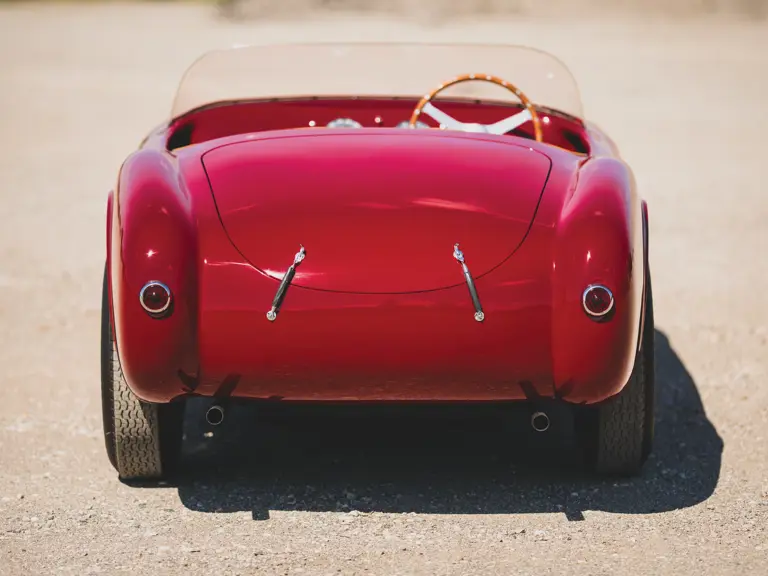








































 | Monterey, California
| Monterey, California



